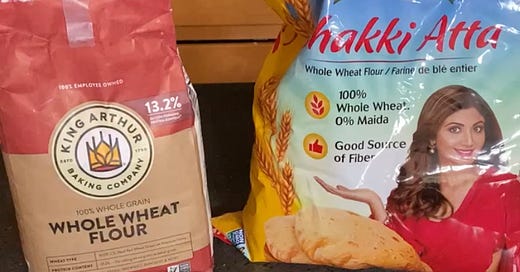Say you moved from India to another country, and you don’t have access to your good ‘ol Atta. You try to make rotis with the regular supermarket whole wheat flour, yet the results may be deeply disappointing. Why is that? Let’s explore the reasons.
You may think a flour is a flour, but the milling process between whole wheat flour and chakki ground atta is different.
But first, a description of both flours. Whole wheat flour is something you buy at a regular supermarket to make your breads, cookies, etc. Chakki atta (in case you are not familiar with it) refers to stone milled whole wheat flour which is available in Indian grocery stores.
Why are the 2 flours different?
It is because of a concept called damaged starches. Whole wheat flours are made with roller mills where the wheat is passed through a series of corrugated and smooth metal rollers. You see, the end goal of a whole wheat flour is to make the wheat rise in breads, so they work hard to limit damaged starches to about 7%.
Atta, on the other hand, is made from stone mills or chakki. You grind the heck out of it. -You use compression, shear, and abrasion forces between the two stones. Here the damaged starches are higher at 15%. The process needs a lot more energy to produce a whole wheat flour with about 15% damaged starches. You might think it is a bad thing, but in the case of roti, it is a wonderful thing. Despite having bran and germ in it, it still produces a remarkably soft end product.
Chakki atta works almost like a refined flour even though it is whole wheat. But, it is not like a panacea for all world problems. There are some issues with it like shelf life and ability to rise in breads with chakki atta, but we will cover that on a later date. For the most part, it is pretty awesome!! Let’s see it in action…
The experiment
I compared King Arthur brand whole wheat flour with Laxmi Brand chakki atta. The King Arthur brand is a popular brand in the US and so is Laxmi brand in India. They are both excellent products. Coincidentally, both had almost the exact same amount of protein (13.3%) and the same amount of fiber (11%). While both are different strains, they share a lot of similarities - Both are hard wheat of the Triticum Aestivum variety. The major difference is in the milling.
I measured the same amount of flour (200g) and used a stand mixer at the same setting to bring the dough together. The whole wheat flour needed less water 128 g to come together as a dough , while atta needed 152 g). The atta flour absorbed more water and also felt very soft to touch.
Now, the whole wheat flour roti does puff, it is the work of gluten after all (gluten is a protein). But the taste is just OK, it is more like “I guess I will eat it since it is healthy”. It is kind of like eating a whole wheat tortilla. Chakki atta roti on the other hand were soft, pliable and tastier than the hard, stiff rotis made with whole wheat flour.
Now, there may be a way to inflict damage on the whole wheat starches by exposing them to heat or something like that. If you have any such trick up your sleeve, mention it in the comments below. But, for the time being I am just doing a normal side to side comparison with no extra steps to process the flours.
Conclusion
If you only have access to whole wheat flour, do not despair. When it is hot, whole wheat flour rotis are decent. They are fine, I am no food elitist. I can eat anything if I am hungry. But if you let it get cold, the difference gets glaring. Cold whole wheat flour rotis were just sad, even for me.
References
Stone Milling versus Roller Milling https://www.ncbi.nlm.nih.gov/pmc/articles/PMC7023360/
Wheat Chemistry and Technology, 4th edition





Thanks for the informative post. Does this mean that western whole wheat flour is better for baking breads, rolls, etc?
Swetha, you answered the question I was looking for. I am Canadian and for about 2 months I couldn't get grocery whole wheat flour [wwf] at my Costco. I make my own no-knead bread, so decided to try the chatti atta, as it was labelled "whole wheat flour" (mechanically milled from Canadian flour). I probably won't be going back to grocery wwf. In the chatti atta bag I bought, I get all the fibre with improved taste. I don't care about carbohydrate damage; I do care about taste, raising, and texture. It was also good to learn about shelf-life (but, as I go through quite a bit of flour in a month, I'll just keep aware against spoilage). TY.